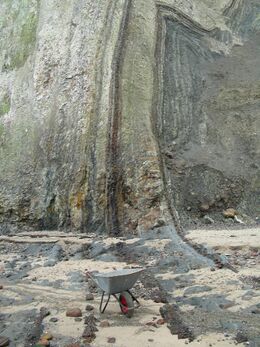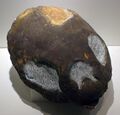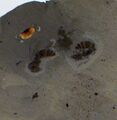Earth:Fur Formation
| Fur Formation Stratigraphic range: Ypresian ~55.8–53.5 Ma | |
|---|---|
 Coastal cliff on the Danish island Fur - Mo-clay and ash layers | |
| Type | Geological formation |
| Sub-units | See: Members |
| Underlies | Røsnes Ler |
| Overlies | Holmehus Formation |
| Thickness | 60 metres (200 ft) |
| Lithology | |
| Primary | Diatomite |
| Location | |
| Coordinates | [ ⚑ ] 56°50′16″N 8°57′43″E / 56.83778°N 8.96194°E |
| Country | |
| Type section | |
| Named for | Fur |
The Fur Formation is a marine geological formation of Ypresian (Lower Eocene Epoch, c. 56.0-54.5 Ma) age which crops out in the Limfjord region of northern Denmark from Silstrup via Mors and Fur to Ertebølle, and can be seen in many cliffs and quarries in the area. The Diatomite Cliffs (moler in Danish) is on the Danish list of tentative candidates for World Heritage and may become a World Heritage site.[1] Fossils found in the Fur Formation are primarily housed at the Fossil and Mo-clay Museum on Mors Island, the Fur Museum on Fur Island, and the Natural History Museum of Denmark (formerly named Geological Museum) in Copenhagen.
Geology
The Fur Formation is a unit of diatomitic sediment approximately 60 meters thick consisting of diatoms and clay minerals with up to 180 layers of volcanic ash.[2] In Danish literature the formation has informally been referred to as the moler (Ler means clay). The diatomite comprises 2/3 opal tests of diatoms and 1/3 clay, interbedded with layers of volcanic ash and a few limestone horizons ('cementstones'), and has exceptionally complete fossil preservation.
It is known for its abundant fossil fish, insects, reptiles, birds and plants. The Fur Formation was deposited just above the Palaeocene-Eocene boundary, about 55 million years ago, and its tropical or sub-tropical flora indicate that the climate after the Paleocene-Eocene Thermal Maximum was moderately warm (approximately 4-8 degrees warmer than today).
Glacial activity has moved and folded all exposed moler in a complicated pattern which permits very precise mapping of glacial movement at the end of the last ice age, and has, due to the ash layers, created an extraordinary pedagogical case for studying tectonics.
Members
The Fur Formation is divided into two members: The lower Knudeklint Member was named for a location on the island of Fur. The upper Silstrup Member was named for a location in Thy. The stratigraphy exposed at Knudeklint constitutes the unit that containing the Paleocene/Eocene boundary informally named Stolleklint Clay, which grades up into the Fur Formation.
Paleontological significance
Fossils of great diversity and unique preservation (only 10 my. after the 'great extinction' of dinosaurs, ammonites etc.) Most unusual, if not unique, diversity of life from both ocean and land with extremely good preservation of details rarely seen, therefore very reliable reconstruction of palaeobiology. By far most of the "Danekræ" fossils (fossils that are considered of national importance and covered by a special law) since 1990 have been found in the Mo-clay area.[3]
Birds
The earliest Paleogene fauna of any diversity, over 30 species, including some near complete, some preserved in 3-D, and some excellent bird-fossils (even with feathers and chromatine). Most are earliest known representatives of their orders (e.g. Trogons, Swifts, Ibises) and all are terrestrial birds.[4][5][6]
- †Lithornithiformes[7]
- Galliformes[8]
- Gruiformes
- Apodiformes (Swifts)
- Charadriiformes[10]
- Psittaciformes[11]
- Musophagiformes
- Coliiformes[12]
- Strigiformes
- Caprimulgiformes
- Coraciiformes
- Trogoniformes
- Primoscenidae
- Trogonidae
- †Septentrogon madseni
-
Septencoracias morsensis
-
Bird skeleton at Fur Museum
-
Bird (Charadriiformes)
-
Bird head with preserved feathers
Reptiles
Several fossil sea turtles are known from the Fur Formation.[6] In one of them, a large leatherback turtle (Eosphargis breineri)[13] remains of soft tissue and skin pigmentation have been recovered[14] A number of well-preserved turtle specimens have been recovered from the formation, two of which have been recognized to be a completely new species of the genus Tasbacka.[15] Sea snakes are also known from the formation.[16][17]
-
Leatherback turtle Eosphargis breineri skull cast, at Geological Museum in Copenhagen.
-
Sea turtle Tasbacka danica Complete unique fossil baby sea turtle. Length 10.5 cm
-
Sea snake Palaeophis sp. in Early Eocene Stolleklint Clay
- Palaeophis (Sea snake)[16][17]
- Eosphargis brenieri (Leatherback turtle)[13]
- Cheloniidae and pan-Cheloniidae[18]
Fish
Large teleostean fauna, oceanic, possibly including earliest truly deep water fish, a 'whale-fish'; earliest members of many living families and Tertiary diversity preserved as complete skeletons; some rare and sensational large and complete specimens (two 'bony tongues', one tarpon.[6][21]
-
Surlykus longigracilis[22] - The most common species of fish in the Fur Formation.
-
Antigonia- Small Eocene fish from the Fur Formation, Denmark.
-
Polymixiid - Early Eocene fish from the Fur Formation, Denmark.
-
Unidentified fish from the Fur Formation at Fur Museum, Denmark
-
Palaeocentrotus
Insects
Huge fauna from land, over 200 species, many are oldest of their families; many with colour spots and eye lenses, some extraordinary preservation with stridulation (sound) apparatus in grasshoppers, and apparently migratory moth mass mortality.[6][23][24][25]
Species described include:
- Cimbrophlebia bittaciformis - a Cimbrophlebiid scorpionfly
- Limfjordia breineri - A dictyopharid plant hopper
- Forficula paleocaenica - a forficulid earwig
- Ypresiomyrma rebekkae - a bull dog ant
-
Forficula paleocaenica earwig
-
Cimbrophlebia bittaciformis (Mecoptera) Fur Museum, Denmark
-
Parasitic wasp
-
Ypresiomyrma rebekkae holotype, in Stolleklint Clay
-
Mosquito (diptera)
-
Mosquito (diptera)
-
Lacewing (Neuroptera)
-
Lacewing Palaeopsychops latifasciatus
Crustacea
Extraordinary cirripeds (barnacles), and the only fossil shrimps from Denmark.[26]
-
Shrimp Penaeus hamleti, Stolleklint Clay
-
Crab Portofuria enigmatica,Stolleklint Clay
-
Shrimp Morscrangon acutus
Molluscs
-
Mussel at Geological Museum in Copenhagen
Land plants
Some members of the 'Arcto-Tertiary flora'; some with cuticle preservation and some flowers preserved. Large silicified trunks (up to 9 m) of redwood, and some very soft wood preserved. Some trunks with mussels and barnacles attached. Many seeds and fruits.[6][27]
-
Undidentified leaf
-
Unidentified leaf
-
Jenkinsella sp. seeds
-
unidentified flower.
Diatoms
Great diversity of unicellular, marine algae with siliceous (opal) tests, 130 species.[28]
Ash layers
More than 200 layers of volcanic ash of predominantly basaltic composition have been found within the Mo-clay of the Fur Formation. 179 of the most prominent ash layers have been numbered. Comparison with volcanic ash layers in oil wells in the North Sea indicates that the Mo-clay is coeval with the Sele Formation and Balder Formation in the North Sea.[29] The ash layers have also been found at other sites in Denmark , England , Austria and the Bay of Biscay.
The total eruption volume of this series have been calculated as 21,000 km3, which occurred in 600,000 years. The most powerful single eruption of this series took place 54.0 million years ago (Ma) and ejected ca. 1,200 km3 of ash material, which makes it one of the largest basaltic pyroclastic eruptions in geological history. [30]
-
Image showing the distinct geological layers.
-
An inland location.
-
These cliffs of Fur have been a rich source of fossils.
-
Mo-clay with layers of volcanic ash
See also
- List of fossiliferous stratigraphic units in Denmark
References
- ↑ "The Heritage Agency of Denmark". http://www.kulturarv.dk/verdensarv/english/candidates/the-diatomite-cliffs-moler/.
- ↑ Pedersen, G.K. & Surlyk, F. 1983: The Fur Formation, a late Paleocene ash-bearing diatomite from northern Denmark. Bulletin Geological Society of Denmark, 32, 43-65.
- ↑ Bonde, N., Andersen, S., Hals, N., and Jakobsen, S.T. (2008). Danekræ - Danmarks bedste fossiler. Copenhagen: Gyldendal. 224 pp.
- ↑ DYKE, G. J., WATERHOUSE, D. M. & KRISTOFFERSEN, A. V. 2004: Three new fossil landbirds from the early Paleogene of Denmark. Bulletin of the Geological Society of Denmark, 51, 47–56.
- ↑ KRISTOFFERSEN, A. V. 2002b. An Early Paleogene trogon (Aves: Trogoniformes) from the Fur Formation, Denmark. Journal of Vertebrate Paleontology, 22, 661–666.
- ↑ 6.0 6.1 6.2 6.3 6.4 Pedersen, G. K., Pedersen, S. A. S., Bonde, N., Heilmann-Clausen, C., Larsen, L. M., Lindow, B., Madsen, H., Pedersen, A. K., Rust, J., Schultz, B. P., Storey, M. og Willumsen, P. S. 2012: Molerområdets geologi – sedimenter, fossiler, askelag og glacialtektonik. Geologisk Tidsskrift 2011, pp. 41–135, [1]
- ↑ LEONARD, L., DYKE, G. J., & TUINEN, M. V. 2005. A new specimen of the fossil palaeognath Lithornis from the Lower Eocene of Denmark. American Museum of Natural History, New York. Number 3491, 11 pp.
- ↑ LINDOW, B.,& DYKE, G. J. 2007. A small galliform bird from the Lower Eocene Fur Formation. Bulletin of the Geological Society of Denmark, vol. 55, 59-63.; LINDOW s 56-63
- ↑ Bertelli, Sara; Chiappe, Luis M.; Mayr, Gerald (2011). "A new Messel rail from the Early Eocene Fur Formation of Denmark (Aves, Messelornithidae)". Journal of Systematic Palaeontology 9 (4): 551–562. doi:10.1080/14772019.2010.538730.
- ↑ BERTELLI, S., LINDOW, B., DYKE, G. J., & CHIAPPE, L. M. 2010. A well-preserved 'Charadriiform-like' fossil bird from the early Eocene Fur Formation of Denmark. Palaeontology, Vol. 53, part 3, 507-531.;LINDOW s 76-117
- ↑ WATERHOUSE, D. M., LINDOW, B., ZELENKOV, N. V., & DYKE, G. J. 2008. Two new parrots (Psittaciformes) From the Lower Eocene Fur Formation of Denmark. Palaeontology, Vol. 51, Part 3, 575-582.
- ↑ DYKE, G.J., WATERHOUSE, D. M., & KRISTOFFERSEN, A.V. 2004. Three new fossil landbirds from the early Paleogene of Denmark, Bulletin of the Geological Society of Denmark. Vol. 51, 77-85. Copenhagen.
- ↑ 13.0 13.1 NIELSEN, E. 1963. On the postcranial skeleton of Eosphargis breineri Nielsen. Meddelelser fra Dansk Geologisk Forening, 15, 281–328
- ↑ Lindgren, Johan; Sjövall, Peter; Carney, Ryan M.; Uvdal, Per; Gren, Johan A.; Dyke, Gareth; Schultz, Bo Pagh; Shawkey, Matthew D. et al. (2014). "Skin pigmentation provides evidence of convergent melanism in extinct marine reptiles". Nature 506 (7489): 484–488. doi:10.1038/nature12899. PMID 24402224. Bibcode: 2014Natur.506..484L.
- ↑ 15.0 15.1 Karl, H.-V. & Madsen, H. (2012): Tasbacka danica n. sp., A new Eocene marine turtle of Denmark (Testudines: Chelonioidea).- Studia Palaeocheloniologica 4: 193-204
- ↑ 16.0 16.1 HOCH, E. 1975. Amniote remnants from the eastern part of the Lower Eocene North Sea Basin. Colloque International du Centre National de la Recherche Scientifique, Paris, 218, 543–562.
- ↑ 17.0 17.1 Kristensen, H.V., Cuny, G., Rasmussen, A.R., ang Madsen, H., 2012: Earliest record of the fossil snake Palaeophis from the Paleocene/Eocene boundary in Denmark. Bull. Soc. géol. France, 2012, t. 183, no 6, p. 623-627
- ↑ 18.0 18.1 De La Garza, R. G.; Madsen, H.; Sjövall, P.; Osbӕck, F.; Zheng, W.; Jarenmark, M.; Schweitzer, M. H.; Engdahl, A. et al. (2022). "An ancestral hard-shelled sea turtle with a mosaic of soft skin and scutes". Scientific Reports 12 (1): 22655. doi:10.1038/s41598-022-26941-1. PMID 36587051. Bibcode: 2022NatSR..1222655D.
- ↑ Nielsen, E., 1959: Eocene Turtles from Denmark, Dansk Geologisk Forening, BD. 14, Hefte 2. p. 96-115 | http://2dgf.dk/xpdf/bull-1959-14-2-96-114.pdf
- ↑ 20.0 20.1 "Danekræ side 12 – Københavns Universitet". http://geologi.snm.ku.dk/samlinger/danekrae/information/danekraeliste/side_12/.
- ↑ BONDE, N. 1997: A distinct fish fauna in the basal ashseries of the Fur/Ølst Formation (U. Paleocene, Denmark). Aarhus Geoscience, 6, 33–48.
- ↑ Schrøder, Anne Elise (2023). "The argentiniform Surlykus longigracilis gen. et sp. nov., the most abundant fish from the Eocene Fur Formation of Denmark". Bulletin of the Geological Society of Denmark 72: 18. https://2dgf.dk/xpdf/bull72-1-18.pdf.
- ↑ ARCHIBALD, S. B. &MARKARKIN, V. N. 2006: Tertiary Giant Lacewings (Neuroptera: Polystoechotidae): Revision and description of new taxa from Western North America and Denmark. Journal of Systematic Palaeontology, 4, 119–155.
- ↑ LARSSON, S.G., 1975: Palaeobiology and mode of burial of the insects of the Lower Eocene Mo-clay of Denmark. Bulletin of the Geological Society of Denmark, vol. 24 p. 193-209. [2]
- ↑ Szwedo, J. (2008). "A new tribe of Dictyopharidae planthoppers from Eocene Baltic amber (Hemiptera: Fulgoromorpha: Fulgoroidea), with a brief review of the fossil record of the family". Palaeodiversity 1: 75–85.
- ↑ GARASSINO, A. & JAKOBSEN, S. L. 2005: Morscrangon acutus n. gen. n. sp. (Crustacea, Decapoda, Caridea) from the Fur Formation (Early Eocene) of the Islands of Mors and Fur (Denmark). Atti Societa italiana di Scienze naturali, Museo civico di Storia nataturale, Milano, 146, 95–107.
- ↑ Sakala, J., & Gryc, V., 2011: A new species of Rhysocaryoxylon (Juglandaceae) from the Lower Eocene Fur Formation of Mors island (northwest Jutland, Denmark). Bulletin of the Geological Society of Denmark, Vol. 59, p 45–49
- ↑ HOMANN, M. 1991. Die Diatomeen der Fur Formation. Geologisches Jahrbuch, A 123, 1–285.
- ↑ Pedersen, S.A.S (2008). "Paleogene diatomite deposits in Denmark: geological investigations and applied aspects". Geological Survey of Denmark and Greenland Bulletin 15: 21–24. doi:10.34194/geusb.v15.5034. http://www.geus.dk/publications/bull/nr15/nr15_p21-24.pdf.
- ↑ Egger, H. and Brückl, E., 2006: Gigantic volcanic eruptions and climatic change in the early Eocene - International Journal of Earth Sciences, Volume 95, Number 6, 1065-1070.
External links
 |






![Unnamed sea turtle, pan-Cheloniidae sp., (specimen DK 807, collected in 2013)[18]](/wiki/images/thumb/e/ea/Pan-Cheloniidae_from_the_Fur_Formation.webp/120px-Pan-Cheloniidae_from_the_Fur_Formation.webp.png)
![Surlykus longigracilis[22] - The most common species of fish in the Fur Formation.](/wiki/images/thumb/1/19/Argentinoid.jpg/120px-Argentinoid.jpg)

























